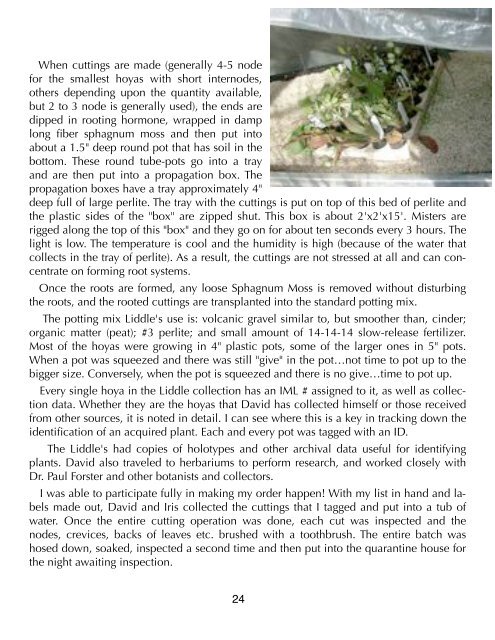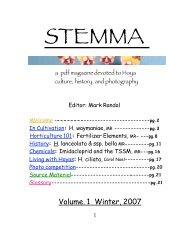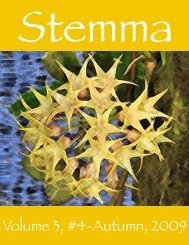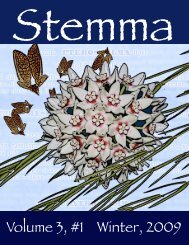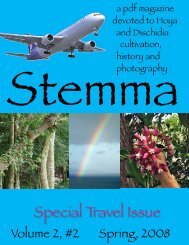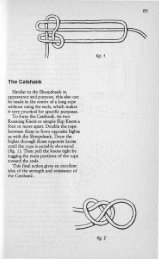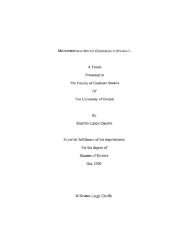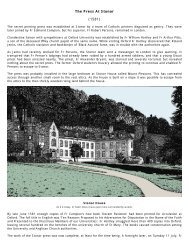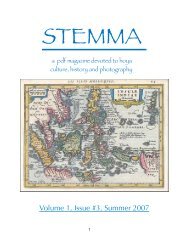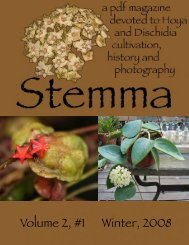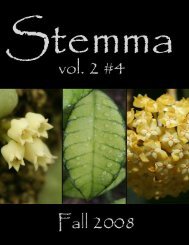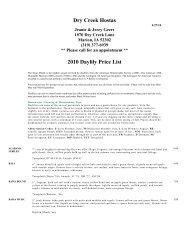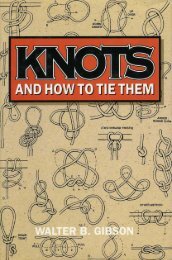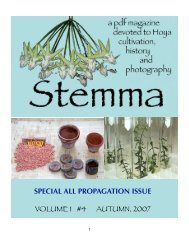Volume 3, Issue #4 - Cubits
Volume 3, Issue #4 - Cubits
Volume 3, Issue #4 - Cubits
You also want an ePaper? Increase the reach of your titles
YUMPU automatically turns print PDFs into web optimized ePapers that Google loves.
When cuttings are made (generally 4-5 node<br />
for the smallest hoyas with short internodes,<br />
others depending upon the quantity available,<br />
but 2 to 3 node is generally used), the ends are<br />
dipped in rooting hormone, wrapped in damp<br />
long fiber sphagnum moss and then put into<br />
about a 1.5" deep round pot that has soil in the<br />
bottom. These round tube-pots go into a tray<br />
and are then put into a propagation box. The<br />
propagation boxes have a tray approximately 4"<br />
deep full of large perlite. The tray with the cuttings is put on top of this bed of perlite and<br />
the plastic sides of the "box" are zipped shut. This box is about 2'x2'x15'. Misters are<br />
rigged along the top of this "box" and they go on for about ten seconds every 3 hours. The<br />
light is low. The temperature is cool and the humidity is high (because of the water that<br />
collects in the tray of perlite). As a result, the cuttings are not stressed at all and can concentrate<br />
on forming root systems.<br />
Once the roots are formed, any loose Sphagnum Moss is removed without disturbing<br />
the roots, and the rooted cuttings are transplanted into the standard potting mix.<br />
The potting mix Liddle's use is: volcanic gravel similar to, but smoother than, cinder;<br />
organic matter (peat); #3 perlite; and small amount of 14-14-14 slow-release fertilizer.<br />
Most of the hoyas were growing in 4" plastic pots, some of the larger ones in 5" pots.<br />
When a pot was squeezed and there was still "give" in the pot…not time to pot up to the<br />
bigger size. Conversely, when the pot is squeezed and there is no give…time to pot up.<br />
Every single hoya in the Liddle collection has an IML # assigned to it, as well as collection<br />
data. Whether they are the hoyas that David has collected himself or those received<br />
from other sources, it is noted in detail. I can see where this is a key in tracking down the<br />
identification of an acquired plant. Each and every pot was tagged with an ID.<br />
The Liddle's had copies of holotypes and other archival data useful for identifying<br />
plants. David also traveled to herbariums to perform research, and worked closely with<br />
Dr. Paul Forster and other botanists and collectors.<br />
I was able to participate fully in making my order happen! With my list in hand and labels<br />
made out, David and Iris collected the cuttings that I tagged and put into a tub of<br />
water. Once the entire cutting operation was done, each cut was inspected and the<br />
nodes, crevices, backs of leaves etc. brushed with a toothbrush. The entire batch was<br />
hosed down, soaked, inspected a second time and then put into the quarantine house for<br />
the night awaiting inspection.<br />
24


